Knitting Sock Heels Top Down
May I introduce you to German short row heels, Dutch heels, toe-up flap heels, and top-down flap heels? This variants are my personal top five of all heel knitting techniques for hand knitted socks.
Knitting Sock Heels is Not Rocket Science
Every sock knitter has got it’s own favorite when it comes to knitting socks. Toe-up or top-down? Long, short or legs with calf shaping? Round toes, band toes or simple “V” toes? And what about the heel?
The variants of heel construction methods for hand knit socks seem to be endless. There are standard flap heels, Dutch heels, boomerang heels, round heels, the hat heel, afterthought heels, toe-up flap heels and many more.
German Short Row Heels
Also known as the Boomerang or Kylie Heel or as Bumerangferse, which is the German term for it. It’s quite popular over here in Germany, actually!
Main features of short row heels: It can be worked as an afterthought heel, has a snuggle fit and is easy to knit if you know how to work short rows. It does not provide additional stitches at the instep which is the main reason I mainly use it in female sock patterns – it’s not the widest version of a heel. But it’s main advantage is that it can be worked on any number of stitches.
The Double Stitch
The Kylie heel uses the German method for working short rows – with a special stitch referred to as “double stitch”. To make a double stitch, insert needle as if to purl with yarn in front. Slip stitch off the needle, pull working yarn strongly to back, so the slipped st falls to the back and the stitch in the row below is pulled up over the right hand needle.
Abbreviations: mds: make double stitch. ds: double stitch.
Knitting German Short Row Heels
The first number you need is the number of total stitches your sock is worked with. Divide this number by two (eventually round to the lower) and call it H ( = number of heel stitches). This heel stitches are going to be divided into three sections: two outer sections, over the short rows (double stitches) are worked, and the center stitches. The number of stitches in these sections are called O (outer stitches) and C (center stitches) below.
Divide H by three and determine the remainder of the division.
If the remainder is zero: O = C = H/3.
If the reminder is 1: O = (H-1) / 3; C = O+1.
If the remainder is 2: C = (H-2) / 3, O = C+1.
As soon as you know the numbers O and C you can start right away.
First half of heel:
- knit O+C+O sts, turn (you’re now on the WS).
- mds, purl O+C+O-1 sts (to last heel st), turn (you’re now on the RS).
- mds, k to next double stitch (ds), turn. Do not work the double stitch!
- mds, p to next ds, turn.
- repeat the last two rows until you have completed O double stitches on each side of the heel.
- knit to end of heel (working each ds as one st), then knit H stitches.
The yarn is positioned at the beginning of the heel again.
Second half of heel:
- K O+C+1 sts, turn.
- mds, purl C + 1 sts, turn.
- mds, knit to next ds, knit ds (as one), k1, and turn.
- mds, purl to next ds, purl ds (as one), p1, and turn.
- repeat the last two rows until you are at the end of both sides (one double stitch left on each side).
That’s it, basically. Give it a try!
An example for a knitting pattern using German short row heels is my knitting pattern Anton shown below.
Dutch Heels
Also known as the square heel, the Dutch heel can be worked without short rows. The main feature are visible, straight lines at the bottom oh the heel and it’s square (well, what else) shape.
The Dutch heel incorporates additional circumference at the instep – but not as much as the standard heel flap – as the stitches of the heel flap are decreased and not short rowed (and therefor staying constant in stitch count).
For example, a sock heel worked over 30 stitches on a 60 stitch sock has got nine stitches left after working a Dutch heel but 30 when working a standard flap heel. This means the instep of a flap heel is 15 stitches wide on each side but just nine stitches total on the Dutch heel.
Here is a Dutch heel pattern template for a 60 stitch sock. The heel itself is worked over 29 stitches.
Heel Flap
Flap setup row 1 (RS): k29, turn work.
Flap setup row 2 (WS): sl1 wyf, p28.
Flap row 1 (RS): sl1 kw, k28, ktbl, turn work.
Flap row 2 (WS): sl1 wyf, p28.
Repeat flap rows 1-2 28 times more. You will have 15 chain sts at edge of heel flap.
Turn Heel
Turn heel row 1 (RS): sl1 kw, k17, ssk, turn work.
Turn heel row 2 (WS): sl1 wyf, p7, p2tog, turn work.
Turn heel row 3-(RS): sl1 kw, k7, ssk, turn work.
Turn heel row 4 (WS): sl1 wyf, p7, p2tog, turn work.
Repeat turn heel rows 3 and 4 until all side sts are used up, 9 sts remain. (39 sts)
Gussets
Work across 9 heel sts, then pick up and k 15 sts on RS of heel flap.
Work across instep sts keeping in pattern (stockinette), then pick up and k 15 sts down left side of heel flap. (69 sts)
Gusset setup: k9, k15 tbl, pm.
Gusset round 1: (work next row of main chart) two times, pm, k15 tbl, k24, slm.
Gusset round 2: (work next row of main chart) two times, slm, ssk, k to 2 sts before next marker, k2tog, slm.
Gusset round 3: (work next row of main chart) two times, slm, k to next marker, slm.
Repeat gusset rounds 2 and 3 until you have 60 sts total again.
It’s really square and the lines of the decreases on the bottom of the heel are quite dominant. But if you see this as a design feature, the Dutch heel is a nice one, especially if you don’t need a really large instep.
An example for a sock knitting pattern using a Dutch heel is my Nano Flowers knitting pattern shown below.
Toe Up Flap Heels
If you prefer to work your socks from toe up but have a weakness for flap heels, this one might be for you.
Basically, it’s a reversed standard flap heel. But instead of increasing by picking up stitches at the flap’s edges and then decreasing, the instep increases are worked first and then decreased as you work up to the ankles.
I created this toe-up flap heel a few years ago when I created my Strausserl Stockings pattern (shown below): my standard short row heel just did not seem to fit such an elegant pair of socks, so I created a new one on the fly: my very own version of toe-up flap heels!
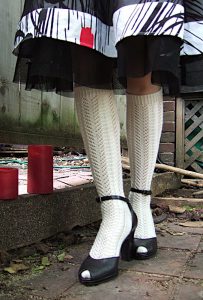
Basically, it’s a reversed standard flap heel, but instead of increasing stitches by picking up stitches at the flap’s edges and decreasing, the instep increases are worked first and then decreased as you work up to the ankles.
Worked this way, the decrease lines (pick up lines at standard flap heels) are clearly visible, a feature which is considered to be a bug by others. It’s all a matter of personal preference, as always in knitting: There’s more than one way to do it!
Pattern Template: Flap Heels for Toe Up Socks
Here’s the pattern outline for my toe-up flap heel. The template uses a stitch count of 60 stitches.
After toes have been worked, work in pattern until foot measures about 3 3⁄4″ (9.5 cm) less than desired length. (You will now increase one stitch at each side of the stockinette sole every other round.) Divide stitches as follows: instep 29 sts, sole 31 sts.
Increase rnd 1: work instep stitches, kfb, k29, kfb.
Increase rnd 2: knit.
Repeat increase rounds 1 and 2 nine times more (10 times total, 10 st increased on each side).
K39 and move 10 sts from needle 2 back to needle 1. Move 10 sts from the end of needle 3 to needle 1. (51, 16, 15 sts on needles 1 (sole), 2, 3)
Heel Short Row 1: k31, turn work.
Heel Short Row 2: p30, w&t.
Heel Short Row 3: k29, w&t.
Heel Short Row 4: p28, w&t.
Heel Short Row 5: k27, w&t.
Heel Short Row 6: p26, w&t.
Heel Short Row 7: k25, w&t.
Heel Short Row 8: p24, w&t.
Heel Short Row 9: k23, w&t.
Heel Short Row 10: p22, w&t.
Heel Short Row 11: k21, w&t.
Heel Short Row 12: p20, w&t.
Heel Short Row 13: k19, w&t.
Heel Short Row 14: p18, w&t.
Heel Short Row 15: k17, w&t.
Heel Short Row 16: p16, w&t.
Heel Short Row 17: k15, w&t.
Heel Short Row 18: p14, w&t.
Heel Short Row 19: k13, w&t.
Heel Short Row 20: p12, w&t.
Heel Short Row 21: k11, w&t.
Heel Short Row 22: p10, w&t.
(You are now facing the RS of your sock again.)
Heel decrease row 1: Knit until one stitch before the end of needle 3, k2tog (the second stitch is taken from needle 1). Turn work.
Heel decrease row 2: Purl until one stitch before the end of needle 2, p2tog (the second stitch is taken from needle 1). Turn work.
Repeat heel decrease rows 1 and 2 until all increased stitches are decreased again (9 times more, 10 times total). (29,16,15) stitches on needles (1, 2, 3); 60 sts total.
Now you can continue knitting the leg!
Standard Flap Heels
The standard cuff-down flap heel is especially suitable for men’s socks as it features a large instep increase and therefor plenty of room for large male feet’s insteps.
The construction schema is simple: work the flap, a few short rows for the turn heel, pick up stitches along the edges of the flap, and then decrease the flap stitches.
In the standard Vanilla flap heel socks you can see on the left, the flap is worked in a simple slipped stitch pattern to increase the heel’s durability. You can of course also just work the heel in plain stockinette stitch or use any other stitch pattern.
Pattern Template: Flap Heel
In the example (heel only) pattern below a total stitch count of 60 stitches in total is used. Assuming you have worked the cuff and the leg and are ready to start the heel, proceed as follows:
Heel Flap
Flap row 1 (RS): (sl 1, k1) 15 times, turn work.
Flap row 2 (WS): sl1 wyf (with yarn in front), p28, ktbl. (Working a ktbl instead of purling the last stitch makes picking up stitches later easier as the edge stitches turn out more defined that way.)
Repeat the last two rows until you have worked 30 rows (15 edge stitches) in total.
Turn Heel
Turn row 1 (RS): k21, turn work.
Turn row 2 (WS): mds (make double stitch – see German short row heel, Heel Week day one), p11, turn work.
Turn row 3 (RS): mds, k to next ds (double stitch), k2, turn work.
Turn row 4 (WS): mds, p to next ds, p2, turn.
Repeat the last two rows until ten double stitches have been worked on each side. You are facing the right side of your sock again.
Instep
Instep setup: K30 (heel), pick up and knit 15 sts along next edge of heel flap, pm (place marker), k30 (front), pm, pick up and knit 15 sts along the other edge of the heel flap, k30 (heel), k15 tbl.
Instep rnd 1: k30 (front), slm, ssk, k to 2 sts before next marker, k2tog, slm.
Instep rnd 2: knit.
Repeat the last two rows until all instep sts are eaten up and 60 sts remain, then continue in pattern for foot.
An example for this type of heel is my free pattern Mike’s Socks shown below.

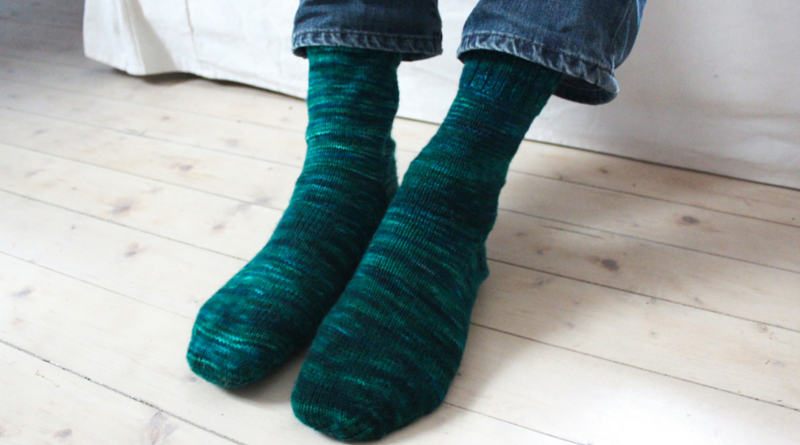
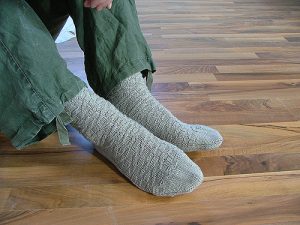
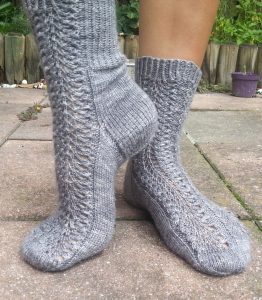
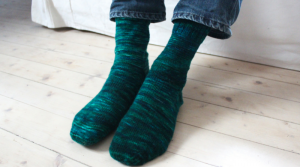
Pingback: Which Sock Heel is the One for You? Knitting Sock Heels - knitting.today
Pingback: Knitting Socks That Fit: Gusset & Instep Knitting - knitting.today